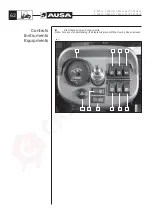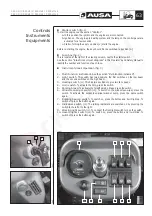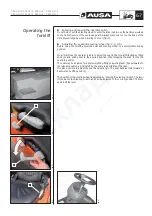
The triangle of horizontal stability
To prevent the loads which are being transported from falling, it is necessary to consider
the triangle of horizontal stability
(fig. 1)
. This is an imaginary inverted triangle, with the
lower end located on the centre of the rear axle and the two upper vertices on each of the
front wheels. Stability is guaranteed when the centre of gravity of the combination load
(c)
+ machine
(m)
remains within the limits of this imaginary triangle.
Longitudinal stabilization
The risk of longitudinal overturning increases if the forklift is driven while the load is
raised. Sharp braking and accelerating or rapid tilting movements decrease stability.
Transversal stability
The risk of overturning sideways increases on turning at incorrect speeds, while the forklift
is unloaded or when the load is raised. Rough ground, sharp braking or accelerating or
shifts in the load make these conditions worse.
Centre of gravity and the capacity of the forklift truck
Do not overload the forklift or handle loads which shift the centre of gravity beyond
that for which it is designed. Manoeuvre slowly, especially when changing direction on
slippery ground .
Do not handle loads that are unstable, loose or disproportionate to the size of the forks
and the forklift machine itself. Make certain that long or wide loads are fastened together
so as to be stable and secure.
The load and counterweight
The load should be lifted and lowered with the mast in vertical position or slightly
tilted backwards. The raised load should only be tilted forwards when it is about to be
unloaded.
Tilting the load forwards or backwards (swinging) is very useful for collecting or
positioning the load, but affects the longitudinal and lateral stability. Therefore, when
handling raised loads, do not swing the mast more than is absolutely essential.
The forklift may tip forwards when carrying a raised load with the mast tilted forwards, or
in the event of sudden braking or accelerating while the load is raised.
If using an accessory, attachment or tool, first check the permitted load. The combination
of the weight of the forklift plus the weight of the accessory or attachment reduces the
nominal load.
WARNING
This forklift is not designed to travel with elevated load or with the mast tilted
forward.
Do not tilt forward the mast with the forks elevated except to pick up or deposit
the load.
The fully forward tilting mast angle is only intended to transport the forklift on a
truck bed, always without load.
For operating with load do not exceed 10º for the forward tilting mast angle.
C 400 H / C 400 HI / C 400 H x4 / C 400 HI x4
C 500 H / C 500 HI / C 500 H x4 / C 500 HI x4
54
(fig. 1)
Special
Safety
Messages




































